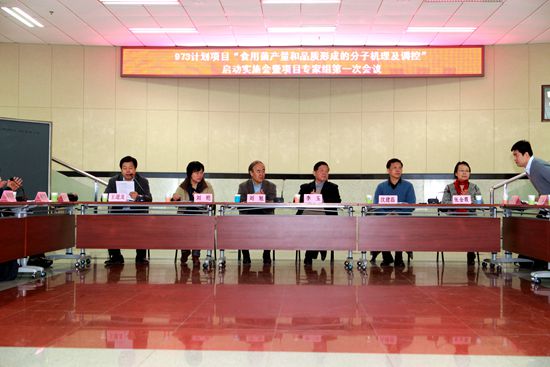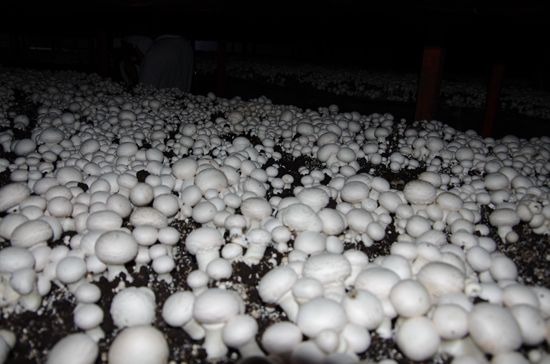分享到
CAAS to launch the first “973 Program” on edible mushroom
On February 15th in Beijing, Chinese Academy of Agricultural Sciences (CAAS) formally launched China’s first major project of the National Basic Research Program of China (973 Program) on edible mushroom – the project of "Molecular Mechanism of Edible Mushroom Yield and Quality and the Regulation".

According to the project chief scientist Professor Zhang Jinxia at the Institute of Agricultural Resources and Regional Planning (IARRP) of CAAS, the emerging edible mushroom industry embraced more than 20 million employees and created an output of 28 million tons and an output value of RMB 170 billion in 2012. However, the absence of systematic and scientific studies results in a continued decline in industrial efficiency and a serious lack of independent intellectual property rights for varieties.
The project is expected to be completed in August 2018. It sets out 5 research topics, namely molecular mechanism for the efficient lignocellulose utilization of edible mushroom, regulating mechanism of edible mushroom fructification and development, molecular mechanism of the temperature response of edible mushroom, molecular basis of active edible mushroom substances and the anabolism, and genetic basis of superior germplasm traits of edible mushroom.

Other researchers participated in this project are mainly from the following institutes and universities: the Institute of Microbiology of Chinese Academy of Sciences, Kunming Institute of Botany of Chinese Academy of Sciences, Institute of Medicinal Plant Development of Chinese Academy of Medical Sciences, Jilin Agricultural University, Beijing Forestry University, Huazhong University of Science and Technology, and Fujian Agriculture and Forestry University, etc.

According to the project chief scientist Professor Zhang Jinxia at the Institute of Agricultural Resources and Regional Planning (IARRP) of CAAS, the emerging edible mushroom industry embraced more than 20 million employees and created an output of 28 million tons and an output value of RMB 170 billion in 2012. However, the absence of systematic and scientific studies results in a continued decline in industrial efficiency and a serious lack of independent intellectual property rights for varieties.
The project is expected to be completed in August 2018. It sets out 5 research topics, namely molecular mechanism for the efficient lignocellulose utilization of edible mushroom, regulating mechanism of edible mushroom fructification and development, molecular mechanism of the temperature response of edible mushroom, molecular basis of active edible mushroom substances and the anabolism, and genetic basis of superior germplasm traits of edible mushroom.

Other researchers participated in this project are mainly from the following institutes and universities: the Institute of Microbiology of Chinese Academy of Sciences, Kunming Institute of Botany of Chinese Academy of Sciences, Institute of Medicinal Plant Development of Chinese Academy of Medical Sciences, Jilin Agricultural University, Beijing Forestry University, Huazhong University of Science and Technology, and Fujian Agriculture and Forestry University, etc.
Latest News
-
 Apr 18, 2024Opening Ceremony of the Training Workshop on Wheat Head Scab Resistance Breeding and Pest Control in Africa Held in CAAS
Apr 18, 2024Opening Ceremony of the Training Workshop on Wheat Head Scab Resistance Breeding and Pest Control in Africa Held in CAAS -
 Apr 03, 2024IPPCAAS Co-organized the Training Workshop on Management and Application of Biopesticides in Nepal
Apr 03, 2024IPPCAAS Co-organized the Training Workshop on Management and Application of Biopesticides in Nepal -
 Mar 28, 2024Delegation from the School of Agriculture and Food Science of University College Dublin, Ireland Visit to IAS, CAAS
Mar 28, 2024Delegation from the School of Agriculture and Food Science of University College Dublin, Ireland Visit to IAS, CAAS -
 Mar 25, 2024Director of World Food Prize Foundation visited GSCAAS
Mar 25, 2024Director of World Food Prize Foundation visited GSCAAS -
 Mar 20, 2024Institute of Crop Sciences (ICS) and Syngenta Group Global Seeds Advance Collaborative Research in the Seed Industry
Mar 20, 2024Institute of Crop Sciences (ICS) and Syngenta Group Global Seeds Advance Collaborative Research in the Seed Industry
